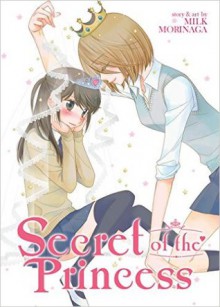
When she was a child, Miu's mother told her that she needed to be cute all the time, because she could meet her prince at any moment. Now that she's in high school, Miu understands that her mother's attitude is a bit old-fashioned, but that hasn't stopped her from taking her advice to heart. She really wants to meet her prince someday and get married.
However, she's currently attending an all-girls school, so it's unlikely she'll meet her prince anytime in the near future. The person she meets instead: Fujiwara, a popular member of the volleyball club. When Miu witnesses Fujiwara accidentally break the principal's expensive vase, Fujiwara begs her not to tell, saying she'll do anything Miu wants. Miu sees this as an opportunity. She asks Fujiwara to go out with her, explaining that it would be good practice for when she finally meets her prince - she'd already know how to be a great girlfriend. Fujiwara agrees because the activities Miu says they'd be doing - walking home together, eating lunch together, texting each other good night, etc. - sound like exactly the kind of friendship activities she has always felt she's been missing out on, due to the way all the other student put her on a pedestal. But what happens when their fake relationship starts to feel real?
I went into this expecting ridiculous and adorable fluff and was a bit surprised when it got a little heavy at times (content warning:
attempted suicide - a character threatens to jump off the school roof
). Considering the premise, I thought some of the implications would be flat-out ignored, but, oddly, Morinaga opted to bring some of it up but just...not fully deal with it all?
I'm torn on this volume. Miu and Fujiwara were cute together, and I loved the way Miu struggled with her gradually shifting perception of her own sexuality after years of her mother's heteronormative pep talks. Her journey from viewing her and Fujiwara's relationship as practice for her eventual "real" relationship with a guy to realizing that she was in love with and attracted to Fujiwara, and that romance between two girls was real and valid too, was nice.
Unfortunately, there were too many details that I didn't think Morinaga properly dealt with. For example, I initially rolled my eyes at the premise, wondering why it didn't occur to Miu that her practice relationship might get her a reputation as a lesbian and hurt her chances at eventually getting a prince. Then there was the possibility of homophobic reactions from others. I figured that Morinaga was just going to ignore those possibilities, and I'd actually have been fine with that. Sometimes it's best if cute, fluffy fiction ignores uglier realities.
Homophobia came up, however, after Miu made her and Fujiwara's relationship public. At first it appeared to just be slight jealousy - Miu's friends viewed Fujiwara as an untouchable idol, and Miu was breaking unspoken rules by actually dating her. Eventually, though, it became clear that jealousy wasn't the only issue. Several of Miu's friends announced that they were no longer going to be Fujiwara's fans because, well, it was a bit weird now that she was publicly a lesbian (those weren't the words they used, but that was the implication - my guess was they were worried they'd be viewed as lesbians too). I'd have expected Miu to be hurt and taken aback, because their rejection of Fujiwara for being a lesbian also indicated, on some level, a rejection of her as well, even though they continued to speak to her and be friends with her. I found it odd that this implication was never addressed or dealt with.
There were a few other little annoying things that weren't really dealt with. For example, one of the maids at Fujiwara's house indicated that she'd been worried when Fujiwara announced that she was bringing a friend home. If the person had been a guy, she wouldn't have allowed him in, but Miu was fine. There was no indication that her view of Miu changed after Fujiwara and Miu went from being in a fake relationship to being in a real one and it made me wonder, a little, if the maid and possibly others were still viewing Miu and Fujiwara's relationship as something less real than a similar relationship between a boy and girl. There was also the implication, in another part of the volume, that romantic relationships didn't really count unless they included physical components, like kissing and sex.
I don't know. It was nice and sweet overall, but there was so much that I felt needed to be properly addressed that wasn't. I wish Morinaga hadn't brought some of that stuff up at all if she wasn't going to do anything with it.
Extras:
"After School Girl," a short manga about an all-girl chemistry club with one particular member who looks a bit like a stereotypical juvenile delinquent and doesn't seem to care about chemistry in the slightest. This isn't explicitly a yuri story, but it could be interpreted as the beginnings of one.
There's also a 2-page author afterword comic that includes a sweet little story from the author's time at an all-girls school.
(Original review posted on A Library Girl's Familiar Diversions.)

 Log in with Facebook
Log in with Facebook 









